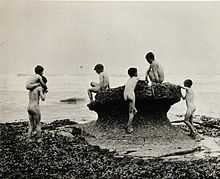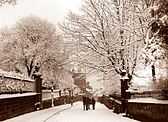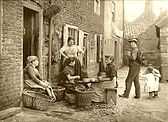Francis Meadow Sutcliffe
| Francis Meadow Sutcliffe | |
|---|---|
 Francis (Frank) Meadow Sutcliffe | |
| Born |
October 6, 1853 Headingley, Leeds |
| Died | May 31, 1941 (aged 87) |
| Occupation | Photographer |
| Known for | "Water Rats" |
| Home town | Sleights, England |
Francis Meadow (Frank) Sutcliffe (6 October 1853 – 31 May 1941) was an English pioneering photographic artist whose work presented an enduring record of life in the seaside town of Whitby, England, and surrounding areas, in the late Victorian era and early 20th century.
Early life
He was born in Headingley, Leeds, to the painter Thomas Sutcliffe and Sarah Lorentia Button. He had an elementary education at a dame school before moving into the new technology of photography.
Career




He made a living as a portrait photographer, working first in Tunbridge Wells, Kent then for the rest of his life in Whitby, living in Broomfield Terrace in Whitby before moving to Sleights, Yorkshire. His father had brought him into contact with prominent figures in the world of art such as John Ruskin, and he resented having to prostitute his art taking photographs of holiday-makers. His business in Skinner Street rooted him to Whitby and the Eskdale valley but, by photographing the ordinary people that he knew well, he built up a most complete and revealing picture of a late Victorian town, and the people who lived and worked there.
His most famous photograph was taken in 1886; Water Rats caused a little comment at the time as it featured naked children playing in a boat,[1] but the image is not erotic. Sutcliffe was using the conventions of the academic nude to show how photography can approach art. He was, however, excommunicated by his local clergy for displaying it, as they thought it would 'corrupt' the opposite sex.[2] Edward VII (then the Prince of Wales) later purchased a copy of the picture.
He was a prolific writer on photographic subjects, contributed to several periodicals, and wrote a regular column in the Yorkshire Weekly Post. His work is in the collection of the Whitby Literary and Philosophical Society and in other national collections.
Personal life
He married Eliza Weatherill Duck, the daughter of a local bootmaker, on 1 January 1875 and had a son and three daughters at his home in Sleights. He died on 31 May 1941 and was buried in Aislaby churchyard.
-

Portrait of Polly Swallow, 1889
-

Girl on the shore, 1889
-

Three happy boys, 1889
-

Fisher girl, 1890
-

Fisher people, c. 1889-90
-

Whitby, 1890
-

Three Naked Boys Around a Coble, 1880s
-

Whitby winter
-

Whitby, 1890
-

Farmers Whitby / Dinner Time, c. 1889-91
-

Whitby, 1890
-

Farmer people Whitby
Notes and references
| Wikimedia Commons has media related to Francis Meadow Sutcliffe. |
- ↑ Busselle, Michael (1985). "The Story of Photography: Frank Meadow Sutcliffe". Encyclopedia of Photography. Hong Kong: Octopus Books. p. 15. ISBN 0-7064-2373-9.
- ↑ Opps - National Media Museum at www.nmpft.org.uk
- Oxford Dictionary of National Biography
- Shaw, Michael (1998). Frank Meadow Sutcliffe - A Fourth Selection. Whitby, North Yorkshire, England: The Sutcliffe Gallery (by agreement with Whitby Literary & Philosophical Society). ISBN 0-9503175-9-4.
External links
- Sutcliffe Gallery
- National Museum of Photography, Film & Television gallery of his works 300+ photographs
| ||||||||||||||||||||||||||||||||||||||